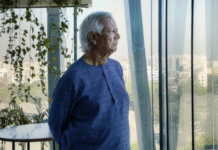Cox’s Bazar and Dhaka, Bangladesh
2021-01-28
 A Rohingya family waits to board a bus taking them to Chittagong en route to Bhashan Char Island, Cox’s Bazar, Bangladesh, Jan. 28, 2021.
A Rohingya family waits to board a bus taking them to Chittagong en route to Bhashan Char Island, Cox’s Bazar, Bangladesh, Jan. 28, 2021.Close to 2,000 more Rohingya left refugee camps in Cox’s Bazar on Thursday as Bangladeshi authorities moved them to a remote island in the Bay of Bengal that international humanitarian organizations have said is inhabitable.
This third batch of refugees was taken in buses to the port city of Chittagong, from where they would board Bangladesh Navy ships bound for Bhashan Char Island on Friday, said Commodore Abdullah Al Mamun Chowdhury, the director of Bhashan Char project.
“On Thursday, 1,800 Rohingya were taken to Chittagong from Cox’s Bazar. By midday Friday, they will reach Bhashan Char from Chittagong,” Chowdhury told BenarNews.
About 1,000 more Rohingya are scheduled to leave the camps in southeastern Bangladesh on Friday and reach the island the next day, he said.
“Some 3,000 Rohingya in total will be relocated to Bhashan Char on Friday and Saturday,” he said.
These latest offshore transfers of refugees will double the population of Rohingya sent to the controversial low-lying island, which has been developed to house refugees in a bid to relieve pressure on crowded mainland camps.
Bangladesh relocated 1,642 Rohingya to Bhashan Char on Dec. 4 and 1,804 on Dec. 29. These Rohingya joined 306 of their compatriots, who were moved to the island after they arrived last May on a dinghy in Teknaf, a sub-district of Cox’s Bazar near the Myanmar-Bangladesh border.
Most of the 1 million Rohingya who fled Myanmar live in 34 refugee camps in and around southeastern district, including more than 740,000 who escaped a brutal crackdown in Rakhine state in 2017.
International humanitarian and rights organizations had said no one should be relocated from Cox’s Bazar until United Nations experts certify that the remote island is habitable, and a mechanism is in place to ensure that refugees are accorded basic human rights.
Fortify Rights, a Southeast Asian group, had said in October that Bangladesh had coerced the Rohingya into moving to Bhashan Char, an allegation that the government had forcefully denied several times.
When Bangladesh started the program in early December, the United Nations said at the time that it had not been involved in preparations for the mass relocation of refugees offshore and had “limited information” on the plan.
The U.N. then confirmed to BenarNews on Dec. 31 that Bangladesh had not yet permitted it to assess the habitability of Bhashan Char, although Dhaka said it was prepared to facilitate U.N. participation.
Bangladesh’s plan is to move 100,000 refugees to Bhashan Char in stages. The government spent about U.S. $280 million to construct housing, a large embankment, cyclone shelters and other infrastructure on the island, officials had said.
Bangladesh touts the relocation as a solution to decongest the camps in Cox’s Bazar. On Bhashan Char, the Rohingya can engage in farming and fishing work, which isn’t possible in the mainland camps, A.K. Abdul Momen, Bangladesh’s foreign minister, told BenarNews last month.
‘I like the atmosphere’
Most of the Rohingya whom BenarNews spoke to last month in Cox’s Bazar said they had voluntarily decided to move to Bhashan Char in the hope of a better life.
On Thursday, other Rohingya expressed similar sentiments before they boarded buses to Chittagong.
“I have decided to move to Bhashan Char for safety, security and a better life, because fighting and lawlessness have become regular features at the Kutupalong camp. In the first phase of relocation, 25 of my relatives moved to the island,” Nurul Islam, a Rohingya refugee, told BenarNews.
“I am thrilled that I can start a new life there.”
Nasima Begum, a Rohingya woman, was also heading to Bhashan Char via Chittagong.
“My relatives living in Bhashan Char have shown us the island via video calls. I like the atmosphere. I would not be worried about safety and security in Bhashan Char,” she said.
Nur Mohammad, a leader in the Shamlapur refugee camp, told BenarNews that more Rohingya from his camp had been showing interest in moving to Bhashan Char.
This shows that Bangladesh has succeeded in its Rohingya relocation plan despite international opposition, said Ehsanul Haque, a professor of international relations at Dhaka University.
“More Rohingya are interested in relocating to Bhashan Char as the people who moved in the first two batches have been leading a good life there. With the increase in the number of people, the U.N. and the international community may change their position on Bhashan Char,” Haque told BenarNews.
“But the government must focus on repatriation of the people to their homeland in Myanmar,” he said.
On Jan. 19, Bangladesh and Myanmar resumed China-brokered talks on Rohingya repatriation for the first time in a year, with Dhaka urging the neighboring country to create conditions in which refugees would agree to return.
The two sides tentatively discussed a fresh attempt to begin repatriation in the second quarter of the new year, though it was not immediately clear what guarantees Rohingya would receive about their safety and livelihood under the plan.
“Myanmar has made all necessary arrangements for the repatriation and reaffirmed Myanmar’s readiness to receive the verified displaced persons in line with the bilateral agreements,” Naypyidaw’s Ministry of Foreign Affairs said in a statement issued after the meeting.









